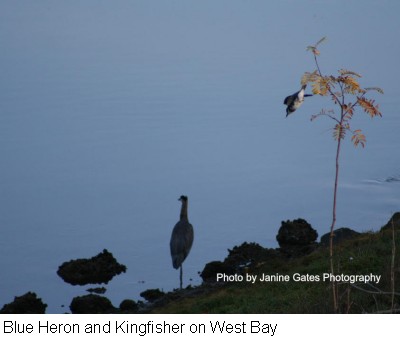It is suggested that a waterbird and raptor species survey be conducted for most of the area of West Bay from Reliable Steel north to Dunlop Towing since this is the area that is likely to be developed in the future. -}
Steve Morrison, Senior Planner with the Thurston Regional Planning Council, says this last survey of waterbird and raptor species that was suggested by the report has not occurred since they haven't been able to find the resources for implementation.
In light of the current proposed development, Bob Morse was asked to comment on this report. Morse states that he was amazed to discover that the population of waterfowl in West Bay had dropped dramatically over the last 20 years with some species seeing an 80% reduction over that period.
"We discovered that most of the water birds, (e.g., ducks and herons), are very skittish when they are feeding in the waters of West Bay or along its edges. If you approach them they stop feeding and fly off and lose the opportunity to continue feeding in their usual areas. My bottom-line suggestion would be to create a vegetative buffer along the western side of West Bay. A plain boardwalk from the Fourth Avenue bridge all the way north is not the answer. A far better solution would be to have a few viewing locations along the shoreline but most of the area kept in native vegetation."
The full West Bay Waterbird Habitat Assessment study can be found at:
http://www.trpc.org/programs/environment/water/westbayhabitatanalysis.htm
For more of the story on wildlife in the West Bay area and impacts of development, see the rest of this story on our website: (add SPEECH/Green Pages online address here and send the following text to our webmaster)
Charlie Kirry, Vice President of the West Bay Neighborhood Association says, "I would be suspect of attempts to characterize as "significant" wildlife from Reliable to Dunlop, as an agenda mainly to stumble redevelopment."
"The vegetative areas from the city's property and southward has been thick through the years. Raccoons and non-indigenous opossum, though, have laid waste to bird nests in these areas over the last 20 years."
"With regard to wildlife, the challenge will be in exploiting the railroad grade. It will be a great trail walk on one hand. On the other hand, keeping distance from wildlife will be a big part of the stewardship of West Bay…that's where the challenges will exist with regard to facilitating wildlife habitat."
"As for my own personal observations of water birds and wildlife, I have seen a lot of life around Smyth Landing, says Sarah Smyth McIntosh. "Red fox, deer, owls, red hawks, ducks, trout, salmon and brown pelicans and /or cormorants...they love the pilings that DNR wants me to take out eventually, but the loons love to sit on them and fan their wings in the sun to dry."
"Any redevelopment of Delson Lumber (my waterfront site), Hardel or the Reliable site will have to have environmental studies done at the project level and these environmental reviews will have to include wildlife," says Smyth McIntosh.
Janine Gates is president of SPEECH and can be reached through her website at www.janinegatesphotography.com.
Back to Home page.

